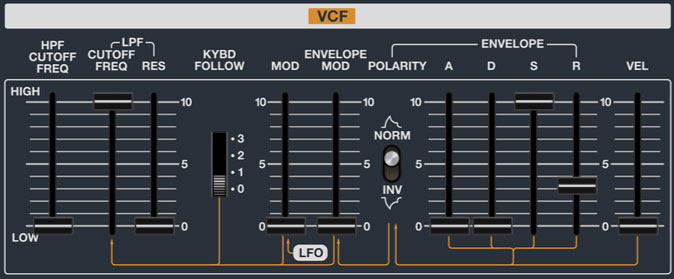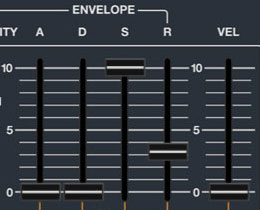
The VCF section consists of a simple 6 db/oct non-resonant highpass filter and a resonant 24 db/oct lowpass filter. The highpass filter (HPF) removes low frequencies as the slider its cutoff slider increased, while the lowpass filter (LPF) removes high frequencies as its cutoff frequency setting is decreased from max, resulting in a dulling of sound.
HPF Cutoff Freq- Sets the frequency where high-frequency attenuation begins, from 20 Hz up to 24,000 Hz. This is a "one-pole" design with a 6dB/oct curve, which means its slope is very gradual - this translates to relatively gentle filtering of low frequencies.
LPF / Cutoff Freq- Sets the frequency where high-frequency attenuation begins, from 20 Hz up to 24,000 Hz. Though it seems odd to have a cutoff control that goes 4000 Hz above human hearing threshold, remember that all filters have a "slope" to their response, so that extra range guarantees you won't hear any filtering at maximum setting. Mercury-4's lowpass filter has a 24db per/octave resulting in a relatively steep "slope" (as well as more pronounced character with the resonance knob turned up).
LPF / Res- Short for “resonance,” this emphasizes sound energy at and around the current cutoff frequency by adding feedback from the filter's output back to its input. At lower settings, this can be used to create mild resonances such as those heard in acoustic instruments.
Mercury-4’s implementation is fully self-oscillating - at extreme settings, it can be used as a sine wave generator, but be careful because high resonance settings can result in loud, screamy, dog-terrifying (and speaker blowing) occurrences. Fun Jupiter-4 feature: its self resonance is particularly loud at low frequencies (i.e. below 150 kHz), which makes it especially well suited for creating booming 808-style kicks, and Mercury-4 accurately replicates this.
Kybd Follow- Commonly known as "keyboard tracking," this causes the cutoff frequency to increase as ascending notes are played on a keyboard. The idea behind this is, because actual note frequencies rise as higher pitches are played, the Kybd Follow switch adds a rising CV to the cutoff frequency in order to maintain the brightness of notes as higher pitches are played. The four switch positions are as follows:
Pos 0- No keyboard tracking; cutoff frequency stays constant across keyboard range.
Pos 1- Cutoff frequency rises roughly four half-steps per octave.
Pos 2- Cutoff frequency rises roughly eight half-steps per octave.
Pos 3- Cutoff frequency rises in 1/2 steps (i.e. same as oscillator pitch). When Res is near or at maximum setting, this position can be used to "play" the filter as a sine wave oscillator in 1/2 steps (use the Cutoff Freq slider to dial in tuning).
(LFO) Mod- Adds cutoff frequency modulation from the low-frequency oscillator section.
Envelope Mod and Polarity switch- The Envelope Mod slider sets the amount of envelope modulation applied from the filter's dedicated envelope generator. With the Polarity switch in the Norm position, envelope mod affects the cutoff frequency positively. In the Inv position, envelope mod is inverted for “reverse” effects (i.e., cutoff frequency is reduced as envelope values increase).
Fun Jupiter-4 feature #2: The filter envelope mod range is enormous, like a modular synth - about 10 octaves. Combining this with the filter's aforementioned loud low-frequency self resonation makes for absolutely wicked res "zaps" that'll knock you across the room. Trust us, this isn't common with softsynths!
Filter Envelope- Mercury-4 includes a dedicated envelope for modulating the filter cutoff frequency. If you're not familiar with the operation of an ADSR envelope generator, please see How An ADSR Envelope Generator Works in the VCA section.

Attack- Defines the length of time for voltage to rise from 0V to 5V when a key is played.
Decay- Defines the length of time for voltage to fall from the attack stage 5V peak to sustain stage setting.
Sustain- Sets the voltage level following attack and decay phases while a note is held.
Release- Defines the length of time for voltage to fall from sustain level to 0V when a key is released.
Vel- Short for "velocity," this defines how much the envelope affects the filter cutoff frequency via keyboard velocity. When set to zero, keyboard velocity has no effect on cutoff frequency; all the way up results in maximum control range.